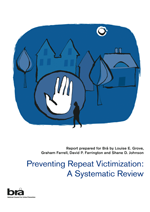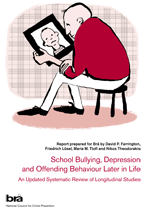- Start
- / Home
- / News from Brå
Systematic reviews help reveal new measures

Illustration by Helena Halvarsson
In all, eleven studies have been produced of the effects of various crime preventing measures in areas ranging from anti-bullying programmes in schools to interventions with adult male violent offenders. The two latest studies focus on repeat victimization and the link between school bullying and later offending behaviour.

Preventing repeat victimization
In any given year, most crimes occur against targets that have already been victimized. The crime prevention strategy deriving from this knowledge is that targeting repeat victimization provides a means of allocating crime prevention resources in an efficient and informed manner. This report presents the findings of a systematic review of 31 studies that evaluate efforts to prevent repeat victimization. Most of the evaluations focus on preventing residential burglary, but commercial burglary, domestic violence, and sexual victimization are also covered.
The main conclusion is that the evidence shows that repeat victimization can be prevented and crime can be reduced. Over all the evaluations, crimes decreased by one-sixth in the prevention condition compared with the control condition. The decreases were greatest (up to one-fifth) for programmes that were designed to prevent repeat burglaries (residential and commercial). There are indications about what factors increase the success of prevention efforts. Appropriately tailored and implemented situational crime prevention measures, such as target hardening and neighbourhood watch, appear to be the most effective. Advice to victims, and education of victims, are less effective.

School Bullying, depression and offending behaviour later in life
Bullying is a problem among children all over the world. In an earlier report in this series, two of the authors of this study have shown that systematic school programs have proven to be effective in preventing bullying. This was an encouraging result. A further question of interest is that of whether bullying also influences the bullies and the victims later on in life in terms of subsequent offending and mental health problems. The answer to this question would reveal whether the prevention of bullying also constitutes a means of preventing future crime and mental health related issues. This is the question answered by the four authors of this report on the basis of a systematic review that includes a number of statistical meta-analyses.
As expected, bullying perpetration at school was a highly significant predictor of offending on average six years later in life. The study clearly shows that bullying and victimization significantly predict later offending and depression, even after controlling for other major childhood risk factors.
Provides us with the overall picture
Systematic reviews combine a number of evaluations that are considered to satisfy a list of empirical criteria for measuring effects as reliably as possible. The results of these evaluations are then used to calculate and produce an overall picture of the effects that a given measure does and does not produce. Systematic reviews aim to systematically combine the results from a number of studies in order to produce a more reliable overview of the opportunities and limitations associated with a given crime prevention strategy.

